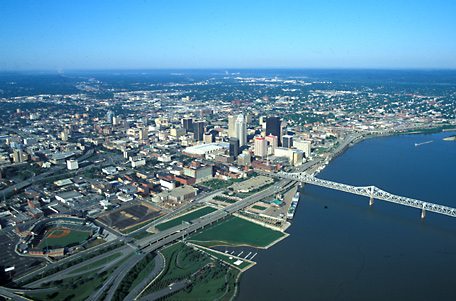In 1778, Colonel George Rogers Clark established a fort at the Falls of the Ohio, a strategic spot on the main travel route through what was then the West, which extended only to the Mississippi River. In 1780 the Virginia General Assembly officially established there a town they named for Louis XVI of France, a staunch supporter of the American War for Independence. It was in the state of Virginia until 1792, when the area on which it centered was admitted to the Union as the fifteenth state, Kentucky.[1]That accounts for the fact that the flags Lewis and Clark flew above their camps and distributed to Indian chiefs contained fifteen stars. See Early American Flags
Here lay the Falls of the Ohio, a two-mile-long series of rapids with a total drop of twenty-six feet. In 1799 Col. Clark’s younger brother William—Billy, his family called him—became involved in a plan of his brother’s to build a canal around the Falls of the Ohio at Louisville, but it came to nothing.
Twenty-six-year-old Lieutenant William Clark retired from the army in 1796 and returned to the vicinity of Louisville, chiefly to help George. There he received a long letter, dated 19 June 1803, from his old army friend, Meriwether Lewis, inviting him to share command of the expedition and outlining the overall plans. “When descending the Ohio,” Lewis wrote, “it shall be my duty by enquiry to find out and engage some good hunters, stout, healthy, unmarried men, accustomed to the woods, and capable of bearing bodily fatigue in a pretty considerable degree: should any young men answering this discription be found in your neighborhood I would thank you to give information of them on my arivall at the falls of the Ohio.” Lewis first stepped ashore at a landing which at that time was just beyond the bridge in the picture, but the best passage through the falls was along the north bank.
At the lower end of the falls, opposite Louisville, was the townsite of Clarksville, Indiana, platted by the Virginia legislature in 1783-84 in recognition of George’s support of the Revolution. Land was also set aside nearby for grants to men who had served under him in his Illinois Regiment. The two brothers established a farm near Clark’s Point, and settled there together early in 1803. It soon became an intermediate staging point for the expedition, and the beginning of Billy Clark’s role as co-commander.[2]James J. Holmberg, Dear Brother: Letters of William Clark to Jonathan Clark (New Haven: Yale University Press, 2002), 80-81.
Among Lewis’s temporary crew when the barge (called the ‘boat’ or ‘barge’ but never the ‘keelboat’) docked at the Falls on October 14 were John Colter and George Shannon, whom Lewis had signed on 200 miles upriver at Maysville, Kentucky. Clark was waiting with seven more recruits who would become permanent members of the contingent soon to be known as the Corps of Volunteers for North Western Discovery—William Bratton, Joseph Field, Reubin Field, Charles Floyd, George Gibson, Nathaniel Pryor, and John Shields. More volunteers for the main party would be enlisted at Fort Massac and Kaskaskia, in Illinois, and St. Charles in Missouri, and others—Hugh Hall, Thomas Howard, and John Potts—would come all the way from the outpost at Fort Southwest Point, Tennessee. Clark brought along his lifelong personal slave, York.
From Discovering Lewis & Clark from the Air
Photography by Jim Wark
Text by Joseph Mussulman
Reproduced by permission of Mountain Press
Notes
| ↑1 | That accounts for the fact that the flags Lewis and Clark flew above their camps and distributed to Indian chiefs contained fifteen stars. See Early American Flags |
|---|---|
| ↑2 | James J. Holmberg, Dear Brother: Letters of William Clark to Jonathan Clark (New Haven: Yale University Press, 2002), 80-81. |
Experience the Lewis and Clark Trail
The Lewis and Clark Trail Experience—our sister site at lewisandclark.travel—connects the world to people and places on the Lewis and Clark Trail.
Discover More
- The Lewis and Clark Expedition: Day by Day by Gary E. Moulton (University of Nebraska Press, 2018). The story in prose, 14 May 1804–23 September 1806.
- The Lewis and Clark Journals: An American Epic of Discovery (abridged) by Gary E. Moulton (University of Nebraska Press, 2003). Selected journal excerpts, 14 May 1804–23 September 1806.
- The Lewis and Clark Journals. by Gary E. Moulton (University of Nebraska Press, 1983–2001). The complete story in 13 volumes.


